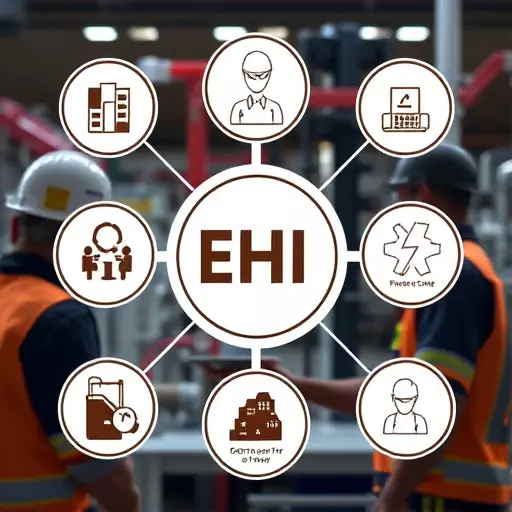An effective Environmental Health and Safety (EHS) program is critical for organizations to maintain regulatory compliance, ensure employee safety, protect environmental integrity, and promote community well-being. The cornerstone of successful EHS program development is a detailed risk assessment that systematically identifies potential hazards and evaluates their associated risks. This process involves scrutinizing all operational aspects to determine necessary safety measures, with the aim of prioritizing safety initiatives and optimizing resource allocation. Organizations must integrate comprehensive risk assessments into their EHS program frameworks to adhere to regulatory standards, understand complex regulations, and establish proactive communication plans. Clear objectives aligned with these requirements form the basis for robust EHS programs, which include protocols for incident reporting, monitoring, and response. To remain resilient in the face of evolving risks and regulatory changes, EHS program development requires continuous improvement and dynamic adaptation. This involves incorporating digital tools and advanced data analytics to enhance the precision and efficacy of compliance strategies, allowing for real-time monitoring and predictive modeling to proactively manage risks. Effective communication protocols are essential for the successful implementation of EHS initiatives, ensuring that all stakeholders—from employees to regulatory bodies—are informed and engaged in maintaining compliance with environmental regulations and occupational safety standards. Regularly monitoring key performance indicators (KPIs) and integrating feedback mechanisms facilitate continuous improvement and responsive adjustments to EHS programs, ultimately leading to safer working conditions and more effective EHS strategies.
Effective environmental, health, and safety (EHS) communication is a linchpin for any robust EHS program. This article delves into essential strategies for developing an EHS program, navigating regulatory compliance, and integrating risk assessment to fortify your EHS initiatives. We’ll explore best practices in EHS communication protocols, techniques for engaging all stakeholders meaningfully, and how to measure the success of these strategies through carefully designed evaluation metrics and feedback mechanisms. Whether you are new to EHS program development or looking to refine existing compliance strategies, this guide offers actionable insights to enhance your EHS communication efforts.
- Laying the Groundwork: EHS Program Development Essentials
- Navigating Regulatory Requirements: EHS Compliance Strategies for Effective Implementation
- Proactive Approaches: Integrating Risk Assessment in EHS Programs
- Communication Protocols: Best Practices for EHS Information Dissemination
- Engaging Stakeholders: Techniques for Inclusive and Effective EHS Communication
- Measuring Success: EHS Communication Strategies Evaluation Metrics and Feedback Mechanisms
Laying the Groundwork: EHS Program Development Essentials

An effective Environmental Health and Safety (EHS) program development is foundational for any organization seeking to maintain compliance with regulations while safeguarding the well-being of its workers, the environment, and the community. The first step in EHS program development involves a comprehensive risk assessment, which is crucial for identifying potential hazards and understanding the associated risks. This process requires a systematic approach, where all operations are scrutinized to pinpoint areas that may pose dangers to personnel or the environment. By conducting thorough risk assessments, organizations can prioritize safety measures and allocate resources effectively.
EHS compliance strategies must be interwoven throughout the program development framework. These strategies encompass a range of activities from regulatory understanding to proactive communication plans. A robust EHS program will have clear objectives aligned with regulatory requirements, thereby ensuring that all compliance aspects are addressed. Additionally, these programs should include a well-defined protocol for reporting, monitoring, and responding to incidents. Effective EHS program development is an ongoing process that requires continuous improvement and adaptation to emerging risks and changing regulations. By focusing on risk assessment as the cornerstone of EHS program development and adhering to compliance strategies, organizations can create resilient safety cultures and foster environments where both employees and the planet are protected.
Navigating Regulatory Requirements: EHS Compliance Strategies for Effective Implementation

In the realm of Environmental, Health, and Safety (EHS), organizations must navigate a complex web of regulatory requirements to ensure compliance and protect both employees and the environment. Effective EHS program development hinges on a thorough understanding of these regulations, which can vary significantly across different jurisdictions. Companies must integrate risk assessment into their EHS program development processes to identify potential hazards, evaluate associated risks, and implement control measures accordingly. This proactive approach not only minimizes the likelihood of non-compliance but also fosters a culture of safety and sustainability within the organization. By systematically evaluating operations against industry standards and legal obligations, businesses can develop tailored EHS compliance strategies that align with their operational goals while safeguarding compliance. These strategies encompass a comprehensive risk management plan, continuous monitoring, and regular training for employees to stay abreast of regulatory changes and safety protocols. In doing so, organizations can effectively manage their EHS responsibilities and mitigate potential liabilities, ensuring smooth operations that comply with all relevant environmental, health, and safety laws. The integration of digital tools and advanced data analytics can further enhance the efficiency and effectiveness of these compliance strategies, enabling real-time monitoring and predictive risk modeling to anticipate and address issues before they escalate. This strategic approach not only demonstrates corporate responsibility but also positions companies to adapt swiftly to new regulatory challenges as they emerge in an ever-evolving compliance landscape.
Proactive Approaches: Integrating Risk Assessment in EHS Programs
In the realm of Environmental, Health, and Safety (EHS) program development, proactive measures are paramount to mitigate potential risks before they manifest into larger issues. Integrating risk assessment within EHS programs serves as a foundational step in this proactive approach. This process involves systematically identifying, analyzing, and evaluating hazards associated with the workplace or environmental factors that could impact health and safety. By conducting thorough risk assessments, organizations can identify potential hazards early on, enabling them to implement controls effectively, thereby enhancing their EHS compliance strategies. This proactive stance not only ensures adherence to regulatory standards but also protects employees and the environment from harm. The insights gained from these assessments are instrumental in developing targeted EHS programs that are tailored to address specific vulnerabilities within an organization’s operations. This strategic integration of risk assessment into program development is a dynamic process that continually evolves with changing conditions, ensuring sustained compliance and safety excellence over time.
The value of integrating risk assessment into the EHS program development cannot be overstated. It allows for the anticipation of potential accidents or health issues, thereby reducing the likelihood of their occurrence. By employing this methodology, organizations can create a more resilient and responsive safety culture, one that is rooted in a deep understanding of the risks associated with various processes and activities. The resulting EHS compliance strategies are not only robust but also adaptable to new challenges as they arise. This proactive integration of risk assessment ensures that EHS programs remain effective and relevant, safeguarding the well-being of all stakeholders and aligning with industry best practices for environmental stewardship and occupational safety.
Communication Protocols: Best Practices for EHS Information Dissemination

Effective communication protocols play a pivotal role in the development and implementation of an EHS, or Environmental Health and Safety, program. To ensure seamless dissemination of information, EHS professionals must establish clear guidelines that facilitate the timely exchange of data related to safety, compliance, and risk management. The cornerstone of robust EHS communication strategies lies in the integration of EHS program development with comprehensive compliance strategies. This synergy allows for a proactive approach to risk assessment within EHS programs, enabling organizations to anticipate potential hazards and address them before they escalate into incidents. Key elements include defining communication channels, regular updates on safety protocols, and clear instructions on reporting mechanisms. By fostering an environment of transparency and responsiveness, companies can enhance their overall preparedness for health and safety challenges.
In the realm of EHS program development, it is imperative to consider the diverse stakeholders who must be informed and engaged. This includes employees at all levels, management, regulatory bodies, and sometimes the broader community impacted by the organization’s activities. Effective communication protocols ensure that information regarding compliance with environmental regulations and occupational safety standards is disseminated appropriately. Risk assessment in EHS programs necessitates a systematic approach to identifying potential risks, evaluating their significance, and determining the necessary actions to mitigate them. By adhering to these best practices, organizations can foster a culture of safety, maintain regulatory compliance, and protect both human health and the environment.
Engaging Stakeholders: Techniques for Inclusive and Effective EHS Communication

In the realm of Environmental, Health, and Safety (EHS) program development, engaging stakeholders is paramount for the success of EHS initiatives. Effective communication strategies ensure that all parties, from employees to regulatory bodies, are informed and aligned with the company’s compliance strategies and risk assessment protocols within EHS programs. Inclusive communication fosters a culture of safety and responsibility, where feedback is encouraged and concerns are addressed proactively. Utilizing diverse channels such as newsletters, safety meetings, and digital platforms, organizations can disseminate information on EHS program developments, ensuring stakeholders are kept up-to-date with the latest compliance requirements and risk assessments. By implementing clear and consistent messaging, companies can enhance understanding and promote adherence to established safety standards, thereby mitigating potential risks and fostering a safer work environment.
To further augment EHS communication effectiveness, organizations should consider integrating multimedia elements like videos or interactive training modules that provide engaging insights into risk assessment methodologies within EHS programs. These tools can simplify complex information, making it more accessible for all stakeholders. Additionally, the use of real-world case studies and scenarios can help in illustrating the importance of compliance and the potential consequences of non-adherence to safety protocols. By employing these techniques, companies not only improve EHS program development but also ensure that all stakeholders are part of a collaborative effort to maintain a safe and healthy workplace, thereby upholding regulatory standards and reducing the likelihood of environmental and health incidents.
Measuring Success: EHS Communication Strategies Evaluation Metrics and Feedback Mechanisms

EHS communication strategies are integral to the successful implementation and continuous improvement of an effective environmental, health, and safety (EHS) program. Key performance indicators (KPIs) must be established early in the EHS program development process to measure the effectiveness of communication efforts. These KPIs can include metrics such as employee engagement levels, participation rates in safety training programs, and the frequency of reported incidents. By regularly monitoring these metrics, organizations can gauge the success of their initiatives and identify areas that require attention or improvement.
Moreover, risk assessment within EHS programs is a critical component that informs communication strategies. It involves systematically evaluating potential hazards and determining appropriate control measures to mitigate risks. Effective feedback mechanisms are essential in this context, allowing for the continuous capture of employee observations, concerns, and suggestions. This two-way dialogue between management and employees not only enhances compliance with safety regulations but also fosters a culture of safety consciousness and proactive risk management. By integrating robust feedback tools such as surveys, suggestion boxes, or interactive platforms, organizations can ensure that EHS communication strategies are responsive to the needs and concerns of their workforce, thereby improving overall program effectiveness and promoting a safer working environment.


